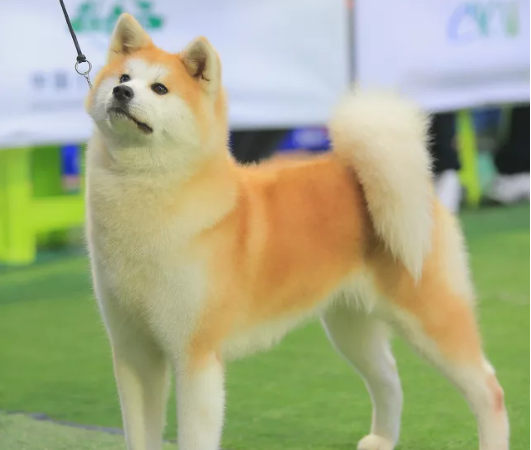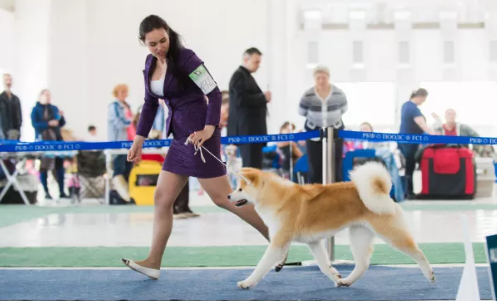FCI国际纯种犬,如何评定秋田
来源:习南之家 |更新时间:2019-04-04|点击次数:
FCI国际纯种犬,如何评定秋田
Originally Japanese dogs were small to medium in size and no large breeds existed。 Since 1603 in the Akita region, Akita Matagis (medium-sized bear-hunting dogs) were used as fighting dogs。  From 1868 Akita Matagis were crossed with Tosas and Mastiffs。 Consequently, the size of this breed increased but characteristics associated with Spitz type were lost。
From 1868 Akita Matagis were crossed with Tosas and Mastiffs。 Consequently, the size of this breed increased but characteristics associated with Spitz type were lost。
In 1908 dog fighting was prohibited, but this breed was nevertheless preserved and improved as a large Japanese breed。 As a result, nine superior examples of this breed were designated as ? Natural Monuments ? in 1931。
During World War II (1939-1945), it was common to use dogs as a source of fur for military garments。 The police ordered the capture and confiscation of all dogs other than German Shepherd Dogs used for military purposes。 Some fanciers tried to circumvent the order by crossbreeding their dogs with German Shepherd Dogs。
When World War II ended, Akitas had been drastically reduced in number and existed as three distinct types) Matagi Akitas) fighting Akitas and) Shepherd Akitas。 This created a very confusing situation in the breed。
During the restoration process of the pure breed after the war、 Kongo-go、 a dog of the Dewa line, which exhibited characteristics of the Mastiff and German Shepherd。
However, sensible learned fanciers did not approve of this type as a proper Japanese breed, so they made efforts to eliminate the strain old foreign breeds by crossbreeding with Matagi Akitas for the purpose of restoring the original pure breed。 They succeeded in stabilizing the pure strain of large sized breed as known today。 GENERAL APPEARANCE:
GENERAL APPEARANCE:
Large-sized dog, sturdily built, well balanced and with much substance ; secondary sex characteristics strongly marked, with high nobility and dignity in modesty ; constitution tough。
IMPORTANT PROPORTIONS:
The ratio of height at withers to length of body ( from the point of the shoulders to the point of the buttock) is 10 : 11, but the body is slightly longer in bitches than in dogs。
Hair: Outer coat harsh and straight, undercoat soft and dense ; the withers and the rump are covered with slightly longer hair ; the hair on tail is longer than on the rest of the body。
Colour:
Red fawn, sesame (red fawn hairs with black tips), brindle and white。 All the above mentioned colours except white must have ? urajiro 。 (Urajiro = whitish coat on the sides of the muzzle, on the cheeks, on the underside of jaw, neck, chest, body and tail and on the inside of the legs)。
 From 1868 Akita Matagis were crossed with Tosas and Mastiffs。 Consequently, the size of this breed increased but characteristics associated with Spitz type were lost。
From 1868 Akita Matagis were crossed with Tosas and Mastiffs。 Consequently, the size of this breed increased but characteristics associated with Spitz type were lost。In 1908 dog fighting was prohibited, but this breed was nevertheless preserved and improved as a large Japanese breed。 As a result, nine superior examples of this breed were designated as ? Natural Monuments ? in 1931。
During World War II (1939-1945), it was common to use dogs as a source of fur for military garments。 The police ordered the capture and confiscation of all dogs other than German Shepherd Dogs used for military purposes。 Some fanciers tried to circumvent the order by crossbreeding their dogs with German Shepherd Dogs。
When World War II ended, Akitas had been drastically reduced in number and existed as three distinct types) Matagi Akitas) fighting Akitas and) Shepherd Akitas。 This created a very confusing situation in the breed。
During the restoration process of the pure breed after the war、 Kongo-go、 a dog of the Dewa line, which exhibited characteristics of the Mastiff and German Shepherd。
However, sensible learned fanciers did not approve of this type as a proper Japanese breed, so they made efforts to eliminate the strain old foreign breeds by crossbreeding with Matagi Akitas for the purpose of restoring the original pure breed。 They succeeded in stabilizing the pure strain of large sized breed as known today。
 GENERAL APPEARANCE:
GENERAL APPEARANCE:Large-sized dog, sturdily built, well balanced and with much substance ; secondary sex characteristics strongly marked, with high nobility and dignity in modesty ; constitution tough。
IMPORTANT PROPORTIONS:
The ratio of height at withers to length of body ( from the point of the shoulders to the point of the buttock) is 10 : 11, but the body is slightly longer in bitches than in dogs。
Hair: Outer coat harsh and straight, undercoat soft and dense ; the withers and the rump are covered with slightly longer hair ; the hair on tail is longer than on the rest of the body。
Colour:
Red fawn, sesame (red fawn hairs with black tips), brindle and white。 All the above mentioned colours except white must have ? urajiro 。 (Urajiro = whitish coat on the sides of the muzzle, on the cheeks, on the underside of jaw, neck, chest, body and tail and on the inside of the legs)。
上一篇:小秋日记,饲养小秋时要注意哪些? 下一篇:秋田犬从配种到生产,你须要知道的常识
看过此文的,还浏览了以下内容
相关推荐
朋友刚看过
热门排行
- 1柯尔鸭是什么鸭子?2021年养柯尔鸭赚钱吗?
- 2养殖业什么最赚钱农村项目,这6个养殖项目,想农村创业的可以试试
- 3野鸡晚上在哪里?几个捕捉野鸡的小技巧_库百科山鸡养殖
- 4梅花鹿的发情鉴定与配种方法_库百科梅花鹿养殖
- 5马的繁殖技术
- 6竹鼠种类图片大全_库百科竹鼠养殖
- 7水貂皮和貂皮的区别_库百科水貂知识_库百科水貂
- 8鸭子要下蛋的前期反应 新鸭下蛋前的征兆
- 9常见蜗牛种类大全 蜗牛的种类大概有多少
- 10地锦草的功效与作用:地锦草治糖尿病是真的吗?
- 11野鸭子是国家保护动物吗_库百科养鸭
- 12水貂好还是貂好_库百科水貂资讯_库百科水貂
- 132021年最新20张大合集来了,看有没有你认识的?
- 14观赏鱼烂尾烂鳍烂鳞用什么药?
- 15穿山甲粉多少钱一克_库百科穿山甲养殖



